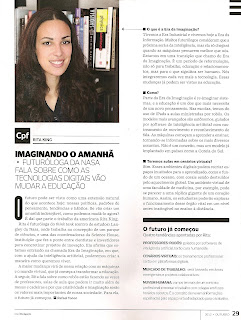Last November, when Joshua and I were invited to give talks about Science House and the Imagination Age in Brazil, I was interviewed for the Brazilian science magazine Galileu. That interview was published this week! Thanks to James Jorasch for the portrait and André Blas for the translation.
Imagining Tomorrow
NASA's futurist speaks about how digital technologies will change education
The future can be seen as a natural extension of what happens today: our policies, thought patterns, tendencies and habits. If an undesirable future can be created, how can we transform it now?
It's from that point that springs the work of Rita J King. Rita is futurist of NASA Langley's think tank, the National Institute of Aerospace, where she works on the conception of a science park, and she is one of the directors of Science House, which serves as a bridge between scientists and investors, for the realization of innovation projects. She states that we are entering in an era called the Imagination Age, in which, with the help of [technology], we can create the ways we want to live our lives.
The greatest change will come from our relationship with machines and the virtual world, which already starts to shape education. Next, Rita talks about robots playing the role of teachers, how classrooms can go well beyond desks and chairs, and why creativity and imagination will be the most important values for our society.
What is the Age of Imagination?
We have had the Industrial Age and today we live the Information Age. Many futurists consider that the next era will be of that of Intelligence, but it will only come to fruition when machines start to think better than us. We are in a transition period I call the Imagination Age. It is a period of reformulation, not only of work, education and relationships, but of what it means to be human. Technology will be increasingly integrated in our lives. These changes can already be seen in education.
How?
Part of the Imagination Age is to re-imagine systems, and education is one which requires new thinking. At schools, we already have iPads and courses administered by robots. The most advanced models are autonomous, guided by artificial intelligence for movement tracking and speech recognition. Machines start to learn how to teach, becoming more knowlegeable
about the most diverse topics. It's not a concept, but a model already implemented in countries such as South Korea.
Will we have classes in virtual scenarios?
Yes. These digital environments can recreate unexpected spaces for learning, such as the bottom of the ocean, with corals being destroyed by global warming. The virtual environment of a school of medicine, for example, can resemble a giant replica of a human heart. That way, students can explore the functioning of that vital organ in a way until then unreachable in the field of distance learning.
The Future has started
Four tendencies pointed out by Rita:
Robot-teachers: guided by artificial intelligence softwares...
Virtual scenarios: professional training done in digital platforms.
Workforce: based in emerging fields and collaborative projects.
Human cloud: we will have more than one professional contract and will collaborate with colleagues in opposite timezones. It is the cloud concept (information scattered through virtual space), adapted for work.







